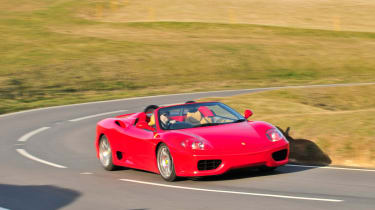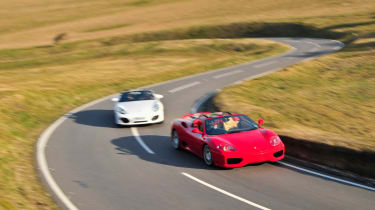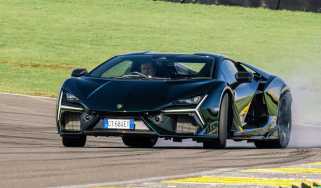Porsche Boxster Spyder v Ferrari 360 Spider - Spyder vs Spider page 3
Everyone loves a spider, particularly when it's powered by a howling V8 or a soulful flat-six...
That said, the 360 is altogether a larger, broader and weightier proposition than the Boxster. Initially, it’s a little intimidating; you don’t feel inclined to hustle it quite as enthusiastically as the Porsche – partly out of respect, partly because you don’t quite know what to expect. Its assisted steering is light enough to be disconcerting at low to medium speeds and lacks the feeling of meaty feedback apparent with the Boxster’s, blurring the information that allows you to make small, line-trimming corrections. And despite the muscular stoppers and generous reserves of grip, it doesn’t inspire the gung-ho confidence the Porsche does. In short, the Boxster feels more in contact with the road, more on-side.
But first impressions can be deceptive. The longer and harder I drive the Ferrari, the more beguiling it becomes. Despite the Porsche’s superior agility, fluency and control, it’s the 360 Spider that emerges as the more intimate and engaging machine at speed on a challenging road. It stimulates with small but critical dynamic cues, everything laid out in finer detail than the Porsche seems capable of.
By the same token, after the Ferrari, the Boxster’s responses feel a little synthetic, tainted by damping effects. The Porsche tells you precisely how hard to go without having to lift off; in the Ferrari the process of finding out for yourself is ultimately more rewarding.
There are clearly areas where the Boxster shows itself to be the more modern car. On poorly-surfaced roads, its ride is extremely firm but the body structure feels vault-solid where the Ferrari’s shakes and shimmies. And the 360 doesn’t feel as secure on the limit, a point where the bond of trust between driver and chassis begins to curl up at the edges. It’s more an impression than a certainty – the 360 plants too much rubber on the road to betray all but the most wreckless of pilots – but sometimes, powering out of medium-to-fast corners it’s hard to tell whether the rear is taking up suspension slack or beginning to slide. Which rather puts a cap on confidence.
And it’s true, the Boxster Spyder can easily keep up on the twisty roads of the South Downs, even teach the Ferrari a few things about chassis neutrality and poise in extremis. It corners harder and with a little more fluidity, though with less communication and less involvement. But the 360 Spider delivers such an intoxicating hit of pure supercar sensation that all of this seems almost unimportant.
Driving the 360 flat-out is just plain thrilling. The scream and shove of that extraordinary flat-plane crank V8 makes a crucial difference. For all its talent as a pure driving machine, the Boxster Spyder isn’t a supercar. The 360 Spider, on the other hand, remains one of the best.








